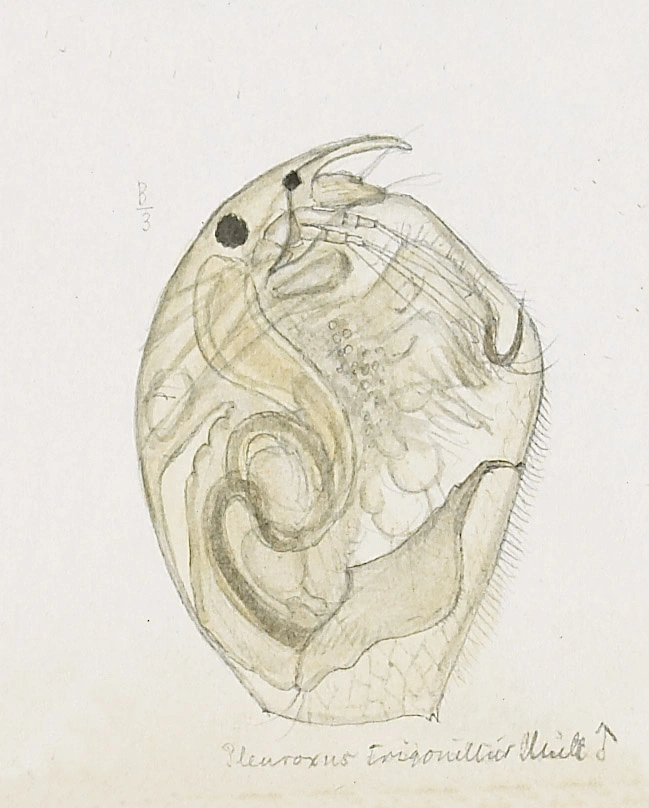Pleuroxus trigonellus
Pleuroxus trigonellus is characterized by the dorsal margin of the carapace which is strongly convex and by the post abdomen which is broad and with 10–14 rather coarse teeth. Though it is found in almost all parts of the country, it may be defined as an easterner.
Key characteristics
Pleuroxus trigonellus (female)
Pleuroxus trigonellus (male)
Pleuroxus trigonellus has an oval shape, where the dorsal margin of the carapace is strongly convex. Its rostrum is not as long as in P. laevis. The postabdomen is broad and has 10–14 rather coarse teeth increasing in size distally. At the basis of each abdominal claw there are two spines, one long and one short. Its colour is brown often with a tinge of red or green.
Female: Length 0.5–0.7 mm
Male: Length 0.5–0.6 mm
Ecology and distribution
Pleuroxus trigonellus is a littoral species recorded from 3 % of the water bodies, mainly from the southeastern part of Norway. However, it is also found in the far north (the counties Troms and Finnmark). It occurs from close to the sea level (6 m a.s.l.) and up to the timber line (964 m a.s.l.) and is found in localities of all sizes. P. trigonellus occurs in dense vegetation as well as on stony bottom. There are records from water bodies with pH ranging from 6.0 to 8.3. This may indicate that the species is acid sensitive. Conductivity is varying between 1 and 42 mS/m.
| Vitenskapelig navn | < 4,5 | 4,5 - 4,9 | 5,0 - 5,4 | 5,5 - 5,9 | 6,0 - 6,4 | 6,5 - 7,0 | 7,0 - 7,4 | > 7,5 |
|---|---|---|---|---|---|---|---|---|
| 0 | 0 | 0 | 0 | 4,6 | 5 | 4,4 | 4 |
| Vitenskapelig navn | < 1,0 | 1,0 - 1,4 | 1,5 - 1,9 | 2,0 - 2,9 | 3,0 - 3,9 | 4,0 - 4,9 | 5,0 - 6,9 | 7,0 - 9,9 | > 10,0 |
|---|---|---|---|---|---|---|---|---|---|
| 0,4 | 0,8 | 1,2 | 2 | 0,4 | 2,5 | 7,1 | 1,9 | 7,5 |
| Vitenskapelig navn | < 0,01 | 0,01 - 0,09 | 0,1 - 0,9 | 1,0 - 9,9 | 10,0 - 99 | 100 - 999 | > 1000 |
|---|---|---|---|---|---|---|---|
| 1 | 4 | 2,1 | 2,2 | 2,1 | 5,6 | 13 |
| Vitenskapelig navn | < 100 | 100-299 | 300-499 | 500-699 | 700-999 | >1000 |
|---|---|---|---|---|---|---|
| 2,9 | 6,1 | 1 | 1,4 | 1,3 | 0 |
Look-alikes
Pleuroxus aduncus


